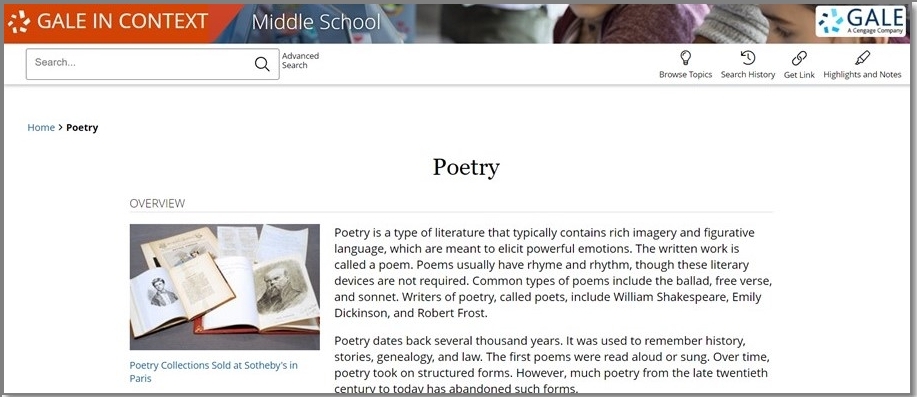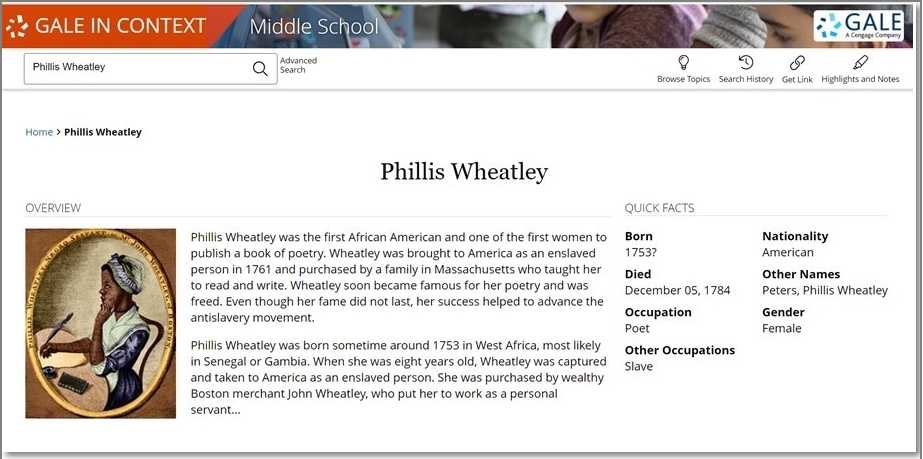|By Gale Staff|
We sometimes overlook the presence of poetry in ordinary experiences. For example, we sing “The Star-Spangled Banner” and rarely recall that it was first a poem written by Francis Scott Key in the aftermath of a British assault during the War of 1812. Only after it was published in newspapers was it set to music. “Method to my madness,” “wild-goose chase,” “green-eyed monster,” “break the ice,” “heart of gold,” and “love is blind” are just a few phrases from William Shakespeare’s literary canon that are common in modern times. We often quote other poets, including Robert Frost (“the road less traveled”), without a second thought. However, despite that we have nearly a lifelong familiarity with it, many of us are intimidated by poetry.

Students often think poetry is hard to understand and even more difficult to write. Poets can invent their own rules about how a poem looks and sounds. This intimidates students who have become used to seeing orderly paragraphs. For example, they may look at a poem and wonder why it’s written with sentences broken into pieces, arranged on different lines, possibly without punctuation or capitalization. They might wonder why some lines are about the same length or consist of one lonely word, while a crowd of other words is hanging out on its own line like friends in the school cafeteria.
Poetry offers a personal yet communal experience. The poet carefully chooses and arranges the words, but readers bring their own ideas, unique life experiences, and moods—all of which shape the meaning they find in a poem.
April is National Poetry Month, an opportunity for teachers, librarians, TikTok poets, and other influencers to introduce students to poetry or expand their knowledge. National Poetry Month was created in 1996 by the Academy of American Poets (and is trademarked by the organization). It’s meant to raise awareness of American poets and their work and encourage the reading and teaching of poetry. But poetry exploration can and should take place year-round.
To introduce students to poetry, educators might first introduce them to extraordinary poets. Phillis Wheatley was one such talent. She was kidnapped in West Africa and enslaved in Boston, Massachusetts, in 1761, when she was seven or eight years old. As a teenager, Wheatley began publishing her poetry and gained international renown for an elegy she wrote in 1770. Students can learn more about this remarkable woman, the first African American to publish a book of poetry, in the Gale In Context: Middle School biography “Phillis Wheatley.”

Technology and social media, which are readily embraced by most teens, are influencing poets and their work. For example, NPR talked to TikTok poet Donovan Beck, who offers tips on how to find inspiration by simply going for a walk and jotting down notes on whatever captures your attention. Find this Weekend All Things Considered interview as well as a video of artist Audrey Nuna reading the Jane Wong poem “I Put on My Fur Coat,” and more, in Gale’s Middle School database of articles, podcasts, and other media.
The architecture of poetry can stymie young readers. An understanding of rhyme and rhythm; lines and stanzas; and various forms of poetry, such as the handy haiku, can help unlock its mysteries. A good introduction to poetry is provided in the Gale In Context: Middle School overview of the topic and in Poetic Forms.
Reading poetry can reinforce a range of skills that students need to develop. Vocabulary, for instance, can be boosted by introducing poems containing unfamiliar words and asking students to consider context clues first, then comparing their understanding with the definitions. Most poetry relies on imagery and other devices to communicate with the reader; these can be identified and discussed. Poetry can illustrate the value of figurative language, such as simile, metaphor, and personification. Writers frequently employ alliteration, which can be taught in the classroom by reading lines aloud and listening to the words.
Beck’s note-taking advice could also be applied to a lesson on writing poetry. Students might jot down a few topics related to their everyday lives and select one to develop. They could choose a topic and reflect on what it means to them. Armed with an idea, students could create lists of related words, consider synonyms, and experiment with rhyme and rhythm.
For many of us, poetry may always be challenging. But with a bit of experience and practice, we and the young people in our lives can learn about ourselves through poetry. In the immortal (yet everyday) words of poet Alexander Pope, “hope springs eternal.”
Josephine Campbell has worked as a journalist, an editor, and a substitute teacher. She is an editor and a content producer for Northeast Editing, Inc. She firmly believes that libraries are among the best places on Earth.
Not a Gale In Context: Middle School subscriber? Learn more about this authoritative database >>

